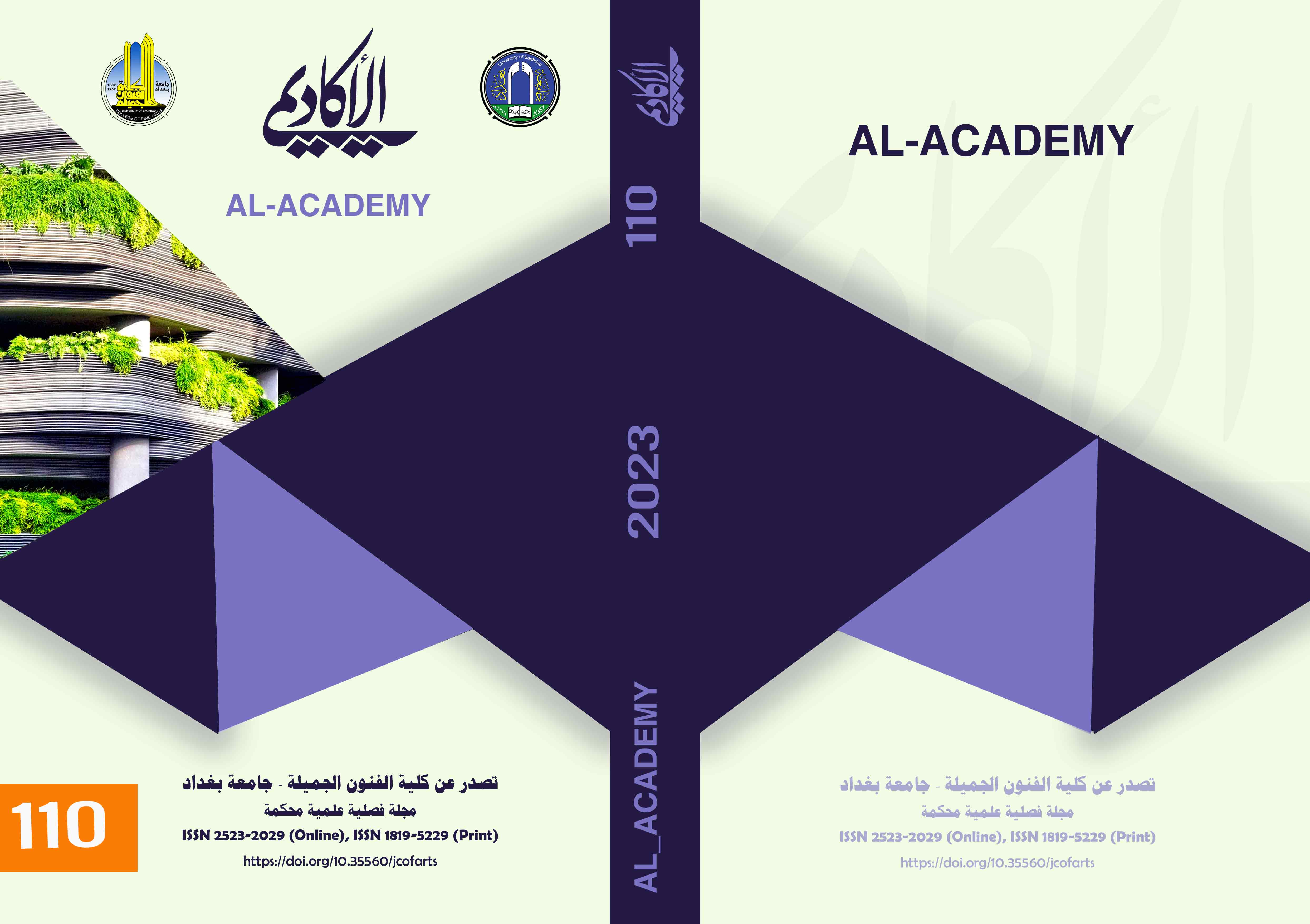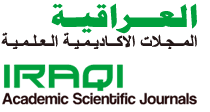Aesthetic approaches and their representations in calligraphic compositions (the Baghdad school - Yaqut Al-Mustasimi and his students as an example)
DOI:
https://doi.org/10.35560/jcofarts1305Keywords:
approaches, representation, beauty, the Baghdad schoolAbstract
This research delves into the aesthetic approaches and representations within the realm of calligraphic compositions, with a specific focus on the Baghdadi School, under the tutelage of Yaqut Al-Mustasimi and his students. By examining the intricate relationship between concepts and their visual manifestations, the study seeks to elucidate the intrinsic meanings embedded in linear compositions and the textual representations that emerge from this dynamic interplay.
Narrowing the scope to the exclusive exploration of calligraphy formations within the Baghdadi School, the theoretical framework, presented in the second chapter, not only introduces the Baghdad school and Yaqut al-Mustasimi's biography but also delves into various aesthetic concepts, encompassing philosophical, literary, and rhetorical elements and their interplay with textual data and composition.
Three noteworthy findings emerged: first, the mutual interaction between conceptual themes and calligraphic text, leading to the creation of expressive and aesthetically rich dimensions firmly grounded in the principles and regulations of Arabic calligraphy. Second, the adaptive nature of letters, enabling them to gracefully conform to the constraints of specific texts and available space, effectively showcasing the textual data and its underlying significance, showcasing the dynamic evolution of Arabic calligraphy. Finally, the concept of improvisation, a cornerstone of the Baghdadi school, emphasizing simplicity as the foundation for mastery.
The third chapter delves into the research methodology and the process of selecting formations, while the fourth chapter reviews key findings, notably emphasizing the sufficiency of letters and words in preserving their initial formal identity. Furthermore, it highlights the inherited characteristic of impromptu intonation, relying on the relative proportions and pen angles, which have been passed down through generations, shaping the essence of Baghdadi calligraphy.
References
Abdel Amir, W. K. (2014). The Conceptual Transformation of Decorative Structure in Islamic Architecture, Department of Arabic Calligraphy and Ornamentation, (PhD thesis). Baghdad: College of Fine Arts, University of Baghdad.
Al Saeed, S. H. (1986). Arabic calligraphy is aesthetic and cultural. ,, , (Vol. Issue 4). Baghdad: Al-Mawrid.
Al-Farabi, A. N. (1986). Opinions of the People of the Virtuous City (2nd ed.). (p. b. Nader, Ed.) Beirut: Dar Al-Mashreq.
Al-Hamawi, S. a.-D.-R. (1938). . Dictionary of Writers, edited by Marjaliyev. Cairo: Al-Mamoun Edition.
Al-Hassan, S. b. (2003). Arabic writing from inscriptions to manuscripts. Riyadh: Al-Faisal Cultural House.
Al-Husseini, I. A. (2001). Technical formation of arabic calligraphy according to thr principles of design (1st ed.). Beirut: Dar Sader.
Al-Isfahani, A. b.-H. (1994). Songs (1st ed.). Beirut: Arab Heritage Revival House.
Al-Jahishyari, A. A. (1938). Ministers and Writers,. (M. a. others, Ed.) Cairo: Al-Halabi edition.
Al-Ketbi, M. b. (1974). Missed deaths . (I. Abbas, Ed.) Beirut: the House of Culture.
Al-Munajjid, S. (1985). Yaqut Al-Mustasmi. Beirut: New Book House.
Al-Nouri, A. A.-Z. (2015). The Aesthetic Tributaries of Islamic Thought and Its Representations in Ornamental Decoration, . Baghdad: unpublished doctoral thesis, College of Fine Arts, University of Baghdad.
Al-Tahanwi, M. A. (1996). Kashaf Encyclopedia of Arts and Sciences Terms. Part 1, ,, . (1st edition ed.). Beirut - Lebanon: Lebanon Library Publishers.
Anwar, S. (1958). The Baghdadi calligrapher Ali bin Hilal, known as Ibn al-Bawab. (A. S. Al-Athari, Trans.) Baghdad: Iraqi Scientific Academy.
Bahnasi, A. (1979). The aesthetics of Arab art. Kuwait: National Council for Culture, Arts and Letters.
Brockelmann, K. (1962). History of Arabic Literature. (A. H. Al-Najjar, Trans.) Cairo: Dar Al-Maaref.
Daoud, A. R. (1997). Building semantic rules in linear configurations. Baghdad: College of Fine Arts, University of Baghdad (PhD thesis).
Dewey, J. (1963). Art and experience. (Z. Ibrahim, Trans.) Cairo: Dar Al-Nahda.
Fadaeli, H. a. (2002). Atlas of calligraphy and fonts (2nd ed.). (M. al-Tunj, Trans.) Damascus: Dar Talas.
Frost, A. a. (1994). Improvisation in Drama. Cairo: Languages and Translation Center, Academy of Arts.
Hanash, A. M. (1990). Arabic calligraphy and the problem of artistic criticism (1st ed.). Baghdad: Al-Umara’ Library for Publishing, Publicity and Advertising.
Ibn Khaldun, A. a.-R. (1981). The Introduction of Ibn Khaldun. 1st edition, 1981. Beirut: Dar Al-Fikr.
Ibn Khalkan, A. A.-D. (1948). Deaths of Notables . (M. M.-D. al-Hamid, Ed.) Egypt: Al-Saada edition.
Ibnmanzur. (1955). arabic tong,Abu Alfieda Gamal al-Din Muhammad. Beirut: Dar Sader.
Issa, Y. S.-A. (2019). Improvisation in the Arts, an applied study on the experience of Augusto Boal’s Theater of the Oppressed. Jordan: Dirasat Journal 288 June.
Johnson, R. 着. (1983). Encyclopedia of critical terminology. Translated by: ,, ,, 1983. ( 2nd Edition ed., Vol. Volume 1). (A. W. Lulua, Trans.) Beirut: Arab Foundation for Studies and Publishing.
Masoud, G. (1992). Al-Raed Dictionary,,, . Lebanon: Dar Al-Ilm Lil-Malayin.
Matar, A. H. (1989). Introduction to Aesthetics and the Philosophy of Art (1st ed.). Cairo: Dar Al-Maaref.
Matlub, A. (2007). A dictionary of rhetorical terms and their development. Beirut: Lebanon Library.
McFarland, H. T.-J. (1994.). Psychology and Education (1st edition ed.). Beirut: Arab House of Science.
Muhammad, A.-B. (1992). Al-Kafi Dictionary, 1st edition,. Beirut: Publications Company.
Nobler, N. (1987). the dialogue of Vision (1st edition ed.). (F. Khalil, Trans.) Baghdad: Dar Al-Ma’moun for Translation and Publishing,.
O'Gorderman, M. (1990). The art of calligraphy, its history and examples of its masterpieces. (S. Saadawi, Trans.) Istanbul.
Reid, H. (1986). Meaning of art (2nd edition ed.). (S. Khashaba, Trans.) Baghdad: House of General Cultural Affairs (Arab Horizons).
Saeed, J. (2004). A dictionary of philosophical terms and evidence. Tunisia: South Publishing House.
Saliba, J. (1982). The Philosophical Dictionary (Vol. 1). Lebanon: Dar Al-Kitab Al-Lubani.
Santayana, G. (2001). The sense of beauty (outlining theory in aesthetics). (M. M. Badawi, Trans.) Cairo: Egyptian General Book Authority, Reading for All Festival.
Sareen, M. (1993). We are made by sin. (M. Hamza, Trans.) Damascus: Dar Al-Taqadum for Printing and Publishing.
Scott, R. G. (1980). Basics of design (2nd ed.). (M. M. Ibrahim, Trans.) Egypt: Dar Nahda.
Wacius, W. (1972). principles of Tow-Dimensional Design. New York: van nostrand Reinhold Company.
Downloads
Published
Issue
Section
License
Copyright (c) 2023 Ahmed Naji Abdel Hassan, Amin Abdul Zahra Yassin Al-Nouri

This work is licensed under a Creative Commons Attribution 4.0 International License.













